Business Finance Report: ANZ Bank Financial Performance Analysis
VerifiedAdded on 2020/12/09
|13
|3965
|405
Report
AI Summary
This report presents a comprehensive financial analysis of ANZ Bank, a major player in the Australian banking sector. It begins with an overview of ANZ Bank, its core activities, and competitive advantages, highlighting its retail and commercial banking services. The report then delves into detailed financial ratio analysis, including liquidity, profitability, and market value ratios, comparing data from 2016-17 and 2017-18 to assess the bank's financial health. The analysis covers debt-to-equity, current, quick, gross profit, net profit, return on capital employed, dividend yield, earnings per share, and book value per share ratios. Furthermore, the report examines share price movements, comparing ANZ's performance to the All Ordinaries Index through graphical representations. Finally, the report calculates the cost of equity and offers concluding recommendations based on the financial data and market trends, providing a thorough evaluation of ANZ Bank's financial standing and investment potential.
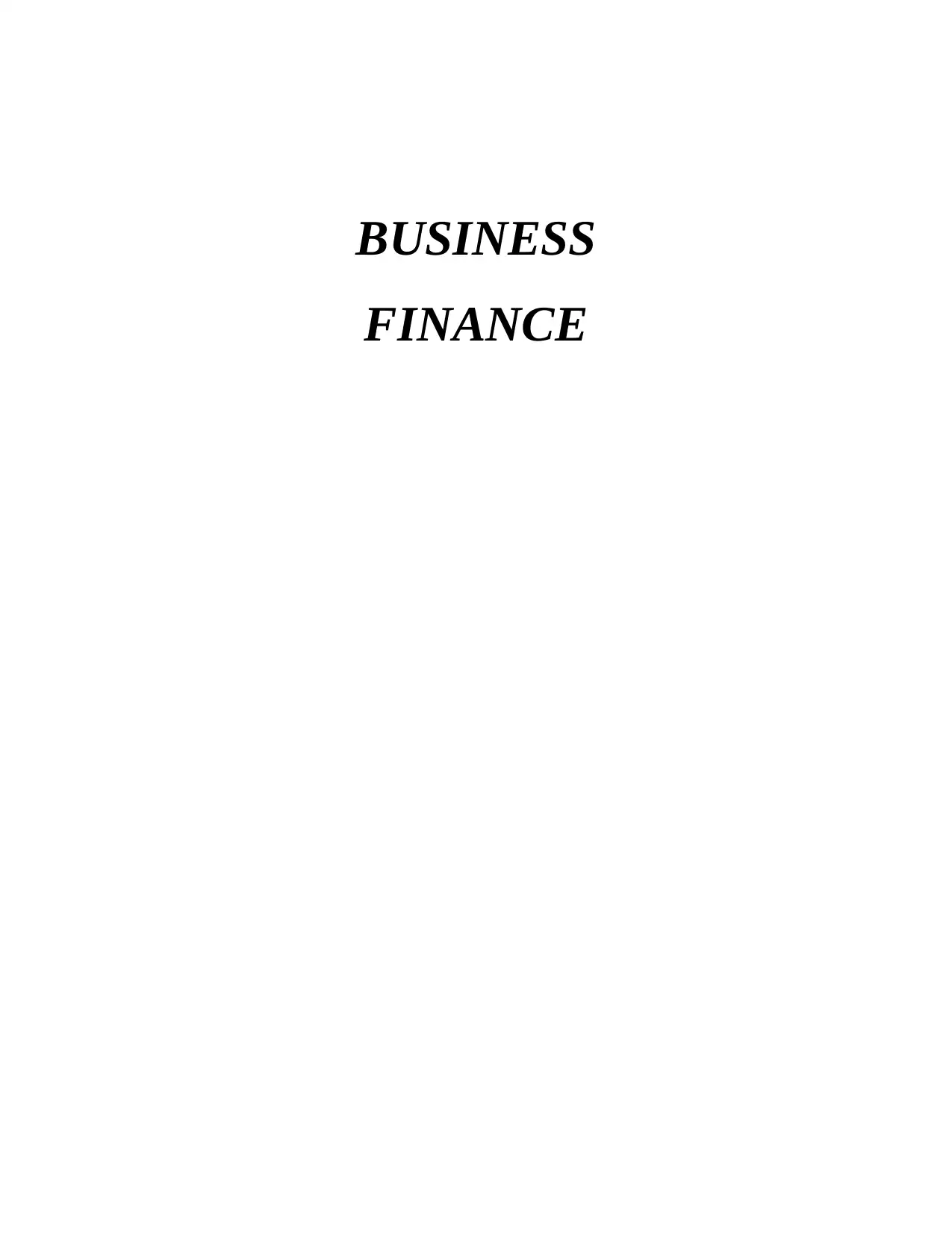
BUSINESS
FINANCE
FINANCE
Paraphrase This Document
Need a fresh take? Get an instant paraphrase of this document with our AI Paraphraser
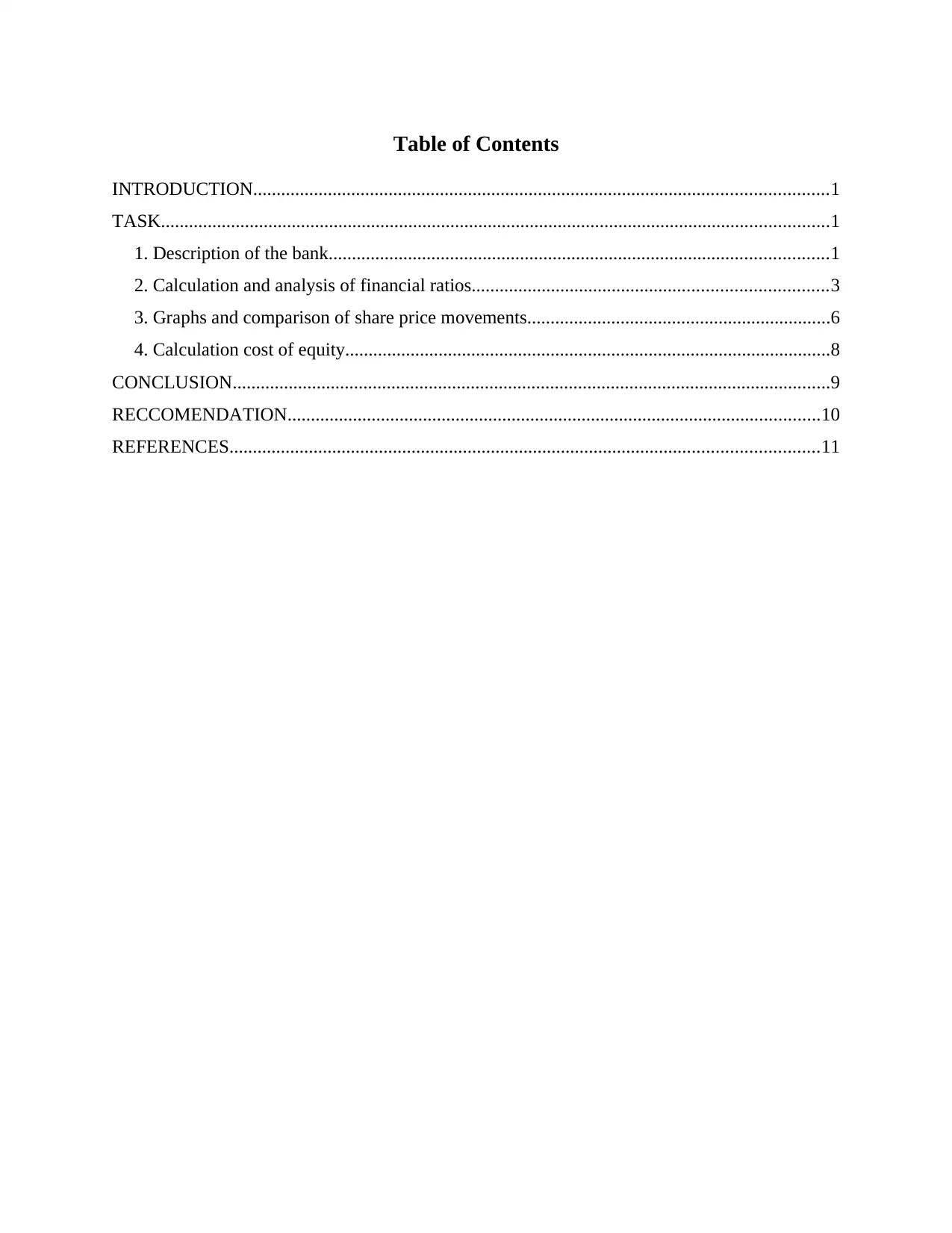
Table of Contents
INTRODUCTION...........................................................................................................................1
TASK...............................................................................................................................................1
1. Description of the bank...........................................................................................................1
2. Calculation and analysis of financial ratios............................................................................3
3. Graphs and comparison of share price movements.................................................................6
4. Calculation cost of equity........................................................................................................8
CONCLUSION................................................................................................................................9
RECCOMENDATION..................................................................................................................10
REFERENCES..............................................................................................................................11
INTRODUCTION...........................................................................................................................1
TASK...............................................................................................................................................1
1. Description of the bank...........................................................................................................1
2. Calculation and analysis of financial ratios............................................................................3
3. Graphs and comparison of share price movements.................................................................6
4. Calculation cost of equity........................................................................................................8
CONCLUSION................................................................................................................................9
RECCOMENDATION..................................................................................................................10
REFERENCES..............................................................................................................................11

INTRODUCTION
Business Finance includes the financial information that belongs from financial document
like as cash flow statements, profit and loss statement and balance sheets (Kay, 2015) . It also
described about business strategies that are used by manager for money invest in business and
make operation more profitable. The report presents an analysis of Australia market for
providing possible recommendation about Australian company for investment to their clients.
For this purpose, ANZ bank is chosen which is the third largest bank by market capitalisation in
Australia, after the common wealth bank and Westpac banking corporation. It was established on
2 March, 1835 for providing banking and financial services. There is focused on core activities
and competitive advantage of bank. In the market operates with in any factors in the company's
history. For understand financial position of bank analysis of financial ratios of two years. There
is presenting graphs and share price movements to know price trend in market and calculate cost
of equity for stock field.
TASK
1. Description of the bank
ANZ is one of the world's largest bank in Australia and New Zealand that provides a
major international banking and financial services group which is included in top 100 bank in the
world. The headquarter of bank situated in Melbourne, where it first opened an office as the bank
of Australasia in 1830s. The operations of bank make up the largest part of ANZ's business, with
commercial bank and retail bank. The bank division offers retail products and services to their
customers with the help of mortgage specialist, branch network, contract centres and third party
brokers. It is providing many facilities related to products for providing comfortability to
consumers like as digital marketing, ATMs, internet banking and phone banking. The bank
provides financial products and services to medium, small and large medium customers,
agribusiness, family groups. ANZ was established on 1 October 1951, when the bank of
Australasia merged with the union bank of Australia limited (Kirschenmann and Norden, 2012).
The name of bank shows in sustainability index making it the 2nd year in a row and ANZ has
been granted the title. The purpose of this bank to provide a shape of the world to communicate
with people to know their incredible things and they are easily buying their home.
Core activities
1
Business Finance includes the financial information that belongs from financial document
like as cash flow statements, profit and loss statement and balance sheets (Kay, 2015) . It also
described about business strategies that are used by manager for money invest in business and
make operation more profitable. The report presents an analysis of Australia market for
providing possible recommendation about Australian company for investment to their clients.
For this purpose, ANZ bank is chosen which is the third largest bank by market capitalisation in
Australia, after the common wealth bank and Westpac banking corporation. It was established on
2 March, 1835 for providing banking and financial services. There is focused on core activities
and competitive advantage of bank. In the market operates with in any factors in the company's
history. For understand financial position of bank analysis of financial ratios of two years. There
is presenting graphs and share price movements to know price trend in market and calculate cost
of equity for stock field.
TASK
1. Description of the bank
ANZ is one of the world's largest bank in Australia and New Zealand that provides a
major international banking and financial services group which is included in top 100 bank in the
world. The headquarter of bank situated in Melbourne, where it first opened an office as the bank
of Australasia in 1830s. The operations of bank make up the largest part of ANZ's business, with
commercial bank and retail bank. The bank division offers retail products and services to their
customers with the help of mortgage specialist, branch network, contract centres and third party
brokers. It is providing many facilities related to products for providing comfortability to
consumers like as digital marketing, ATMs, internet banking and phone banking. The bank
provides financial products and services to medium, small and large medium customers,
agribusiness, family groups. ANZ was established on 1 October 1951, when the bank of
Australasia merged with the union bank of Australia limited (Kirschenmann and Norden, 2012).
The name of bank shows in sustainability index making it the 2nd year in a row and ANZ has
been granted the title. The purpose of this bank to provide a shape of the world to communicate
with people to know their incredible things and they are easily buying their home.
Core activities
1
⊘ This is a preview!⊘
Do you want full access?
Subscribe today to unlock all pages.

Trusted by 1+ million students worldwide
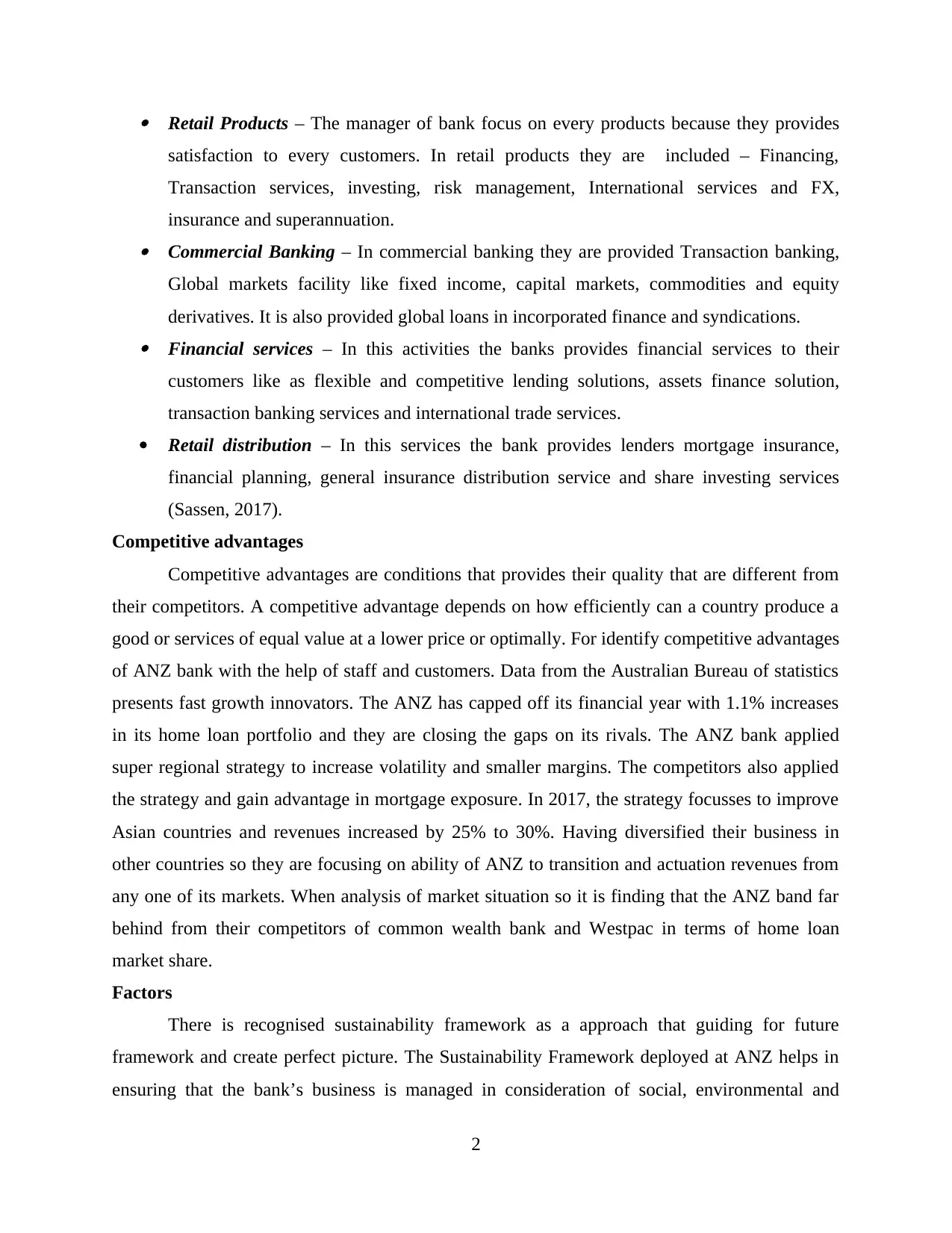
Retail Products – The manager of bank focus on every products because they provides
satisfaction to every customers. In retail products they are included – Financing,
Transaction services, investing, risk management, International services and FX,
insurance and superannuation. Commercial Banking – In commercial banking they are provided Transaction banking,
Global markets facility like fixed income, capital markets, commodities and equity
derivatives. It is also provided global loans in incorporated finance and syndications. Financial services – In this activities the banks provides financial services to their
customers like as flexible and competitive lending solutions, assets finance solution,
transaction banking services and international trade services.
Retail distribution – In this services the bank provides lenders mortgage insurance,
financial planning, general insurance distribution service and share investing services
(Sassen, 2017).
Competitive advantages
Competitive advantages are conditions that provides their quality that are different from
their competitors. A competitive advantage depends on how efficiently can a country produce a
good or services of equal value at a lower price or optimally. For identify competitive advantages
of ANZ bank with the help of staff and customers. Data from the Australian Bureau of statistics
presents fast growth innovators. The ANZ has capped off its financial year with 1.1% increases
in its home loan portfolio and they are closing the gaps on its rivals. The ANZ bank applied
super regional strategy to increase volatility and smaller margins. The competitors also applied
the strategy and gain advantage in mortgage exposure. In 2017, the strategy focusses to improve
Asian countries and revenues increased by 25% to 30%. Having diversified their business in
other countries so they are focusing on ability of ANZ to transition and actuation revenues from
any one of its markets. When analysis of market situation so it is finding that the ANZ band far
behind from their competitors of common wealth bank and Westpac in terms of home loan
market share.
Factors
There is recognised sustainability framework as a approach that guiding for future
framework and create perfect picture. The Sustainability Framework deployed at ANZ helps in
ensuring that the bank’s business is managed in consideration of social, environmental and
2
satisfaction to every customers. In retail products they are included – Financing,
Transaction services, investing, risk management, International services and FX,
insurance and superannuation. Commercial Banking – In commercial banking they are provided Transaction banking,
Global markets facility like fixed income, capital markets, commodities and equity
derivatives. It is also provided global loans in incorporated finance and syndications. Financial services – In this activities the banks provides financial services to their
customers like as flexible and competitive lending solutions, assets finance solution,
transaction banking services and international trade services.
Retail distribution – In this services the bank provides lenders mortgage insurance,
financial planning, general insurance distribution service and share investing services
(Sassen, 2017).
Competitive advantages
Competitive advantages are conditions that provides their quality that are different from
their competitors. A competitive advantage depends on how efficiently can a country produce a
good or services of equal value at a lower price or optimally. For identify competitive advantages
of ANZ bank with the help of staff and customers. Data from the Australian Bureau of statistics
presents fast growth innovators. The ANZ has capped off its financial year with 1.1% increases
in its home loan portfolio and they are closing the gaps on its rivals. The ANZ bank applied
super regional strategy to increase volatility and smaller margins. The competitors also applied
the strategy and gain advantage in mortgage exposure. In 2017, the strategy focusses to improve
Asian countries and revenues increased by 25% to 30%. Having diversified their business in
other countries so they are focusing on ability of ANZ to transition and actuation revenues from
any one of its markets. When analysis of market situation so it is finding that the ANZ band far
behind from their competitors of common wealth bank and Westpac in terms of home loan
market share.
Factors
There is recognised sustainability framework as a approach that guiding for future
framework and create perfect picture. The Sustainability Framework deployed at ANZ helps in
ensuring that the bank’s business is managed in consideration of social, environmental and
2
Paraphrase This Document
Need a fresh take? Get an instant paraphrase of this document with our AI Paraphraser
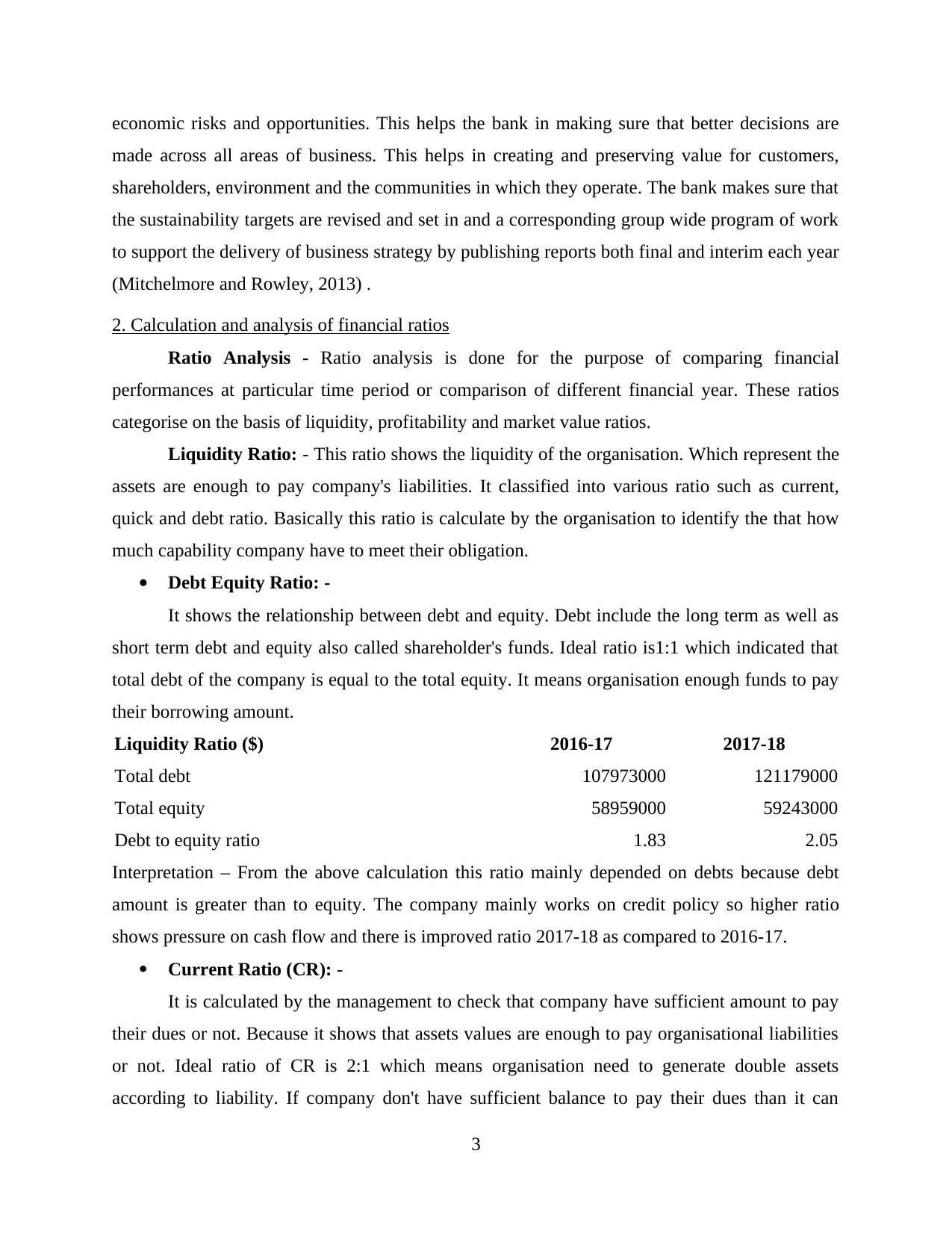
economic risks and opportunities. This helps the bank in making sure that better decisions are
made across all areas of business. This helps in creating and preserving value for customers,
shareholders, environment and the communities in which they operate. The bank makes sure that
the sustainability targets are revised and set in and a corresponding group wide program of work
to support the delivery of business strategy by publishing reports both final and interim each year
(Mitchelmore and Rowley, 2013) .
2. Calculation and analysis of financial ratios
Ratio Analysis - Ratio analysis is done for the purpose of comparing financial
performances at particular time period or comparison of different financial year. These ratios
categorise on the basis of liquidity, profitability and market value ratios.
Liquidity Ratio: - This ratio shows the liquidity of the organisation. Which represent the
assets are enough to pay company's liabilities. It classified into various ratio such as current,
quick and debt ratio. Basically this ratio is calculate by the organisation to identify the that how
much capability company have to meet their obligation.
Debt Equity Ratio: -
It shows the relationship between debt and equity. Debt include the long term as well as
short term debt and equity also called shareholder's funds. Ideal ratio is1:1 which indicated that
total debt of the company is equal to the total equity. It means organisation enough funds to pay
their borrowing amount.
Liquidity Ratio ($) 2016-17 2017-18
Total debt 107973000 121179000
Total equity 58959000 59243000
Debt to equity ratio 1.83 2.05
Interpretation – From the above calculation this ratio mainly depended on debts because debt
amount is greater than to equity. The company mainly works on credit policy so higher ratio
shows pressure on cash flow and there is improved ratio 2017-18 as compared to 2016-17.
Current Ratio (CR): -
It is calculated by the management to check that company have sufficient amount to pay
their dues or not. Because it shows that assets values are enough to pay organisational liabilities
or not. Ideal ratio of CR is 2:1 which means organisation need to generate double assets
according to liability. If company don't have sufficient balance to pay their dues than it can
3
made across all areas of business. This helps in creating and preserving value for customers,
shareholders, environment and the communities in which they operate. The bank makes sure that
the sustainability targets are revised and set in and a corresponding group wide program of work
to support the delivery of business strategy by publishing reports both final and interim each year
(Mitchelmore and Rowley, 2013) .
2. Calculation and analysis of financial ratios
Ratio Analysis - Ratio analysis is done for the purpose of comparing financial
performances at particular time period or comparison of different financial year. These ratios
categorise on the basis of liquidity, profitability and market value ratios.
Liquidity Ratio: - This ratio shows the liquidity of the organisation. Which represent the
assets are enough to pay company's liabilities. It classified into various ratio such as current,
quick and debt ratio. Basically this ratio is calculate by the organisation to identify the that how
much capability company have to meet their obligation.
Debt Equity Ratio: -
It shows the relationship between debt and equity. Debt include the long term as well as
short term debt and equity also called shareholder's funds. Ideal ratio is1:1 which indicated that
total debt of the company is equal to the total equity. It means organisation enough funds to pay
their borrowing amount.
Liquidity Ratio ($) 2016-17 2017-18
Total debt 107973000 121179000
Total equity 58959000 59243000
Debt to equity ratio 1.83 2.05
Interpretation – From the above calculation this ratio mainly depended on debts because debt
amount is greater than to equity. The company mainly works on credit policy so higher ratio
shows pressure on cash flow and there is improved ratio 2017-18 as compared to 2016-17.
Current Ratio (CR): -
It is calculated by the management to check that company have sufficient amount to pay
their dues or not. Because it shows that assets values are enough to pay organisational liabilities
or not. Ideal ratio of CR is 2:1 which means organisation need to generate double assets
according to liability. If company don't have sufficient balance to pay their dues than it can
3
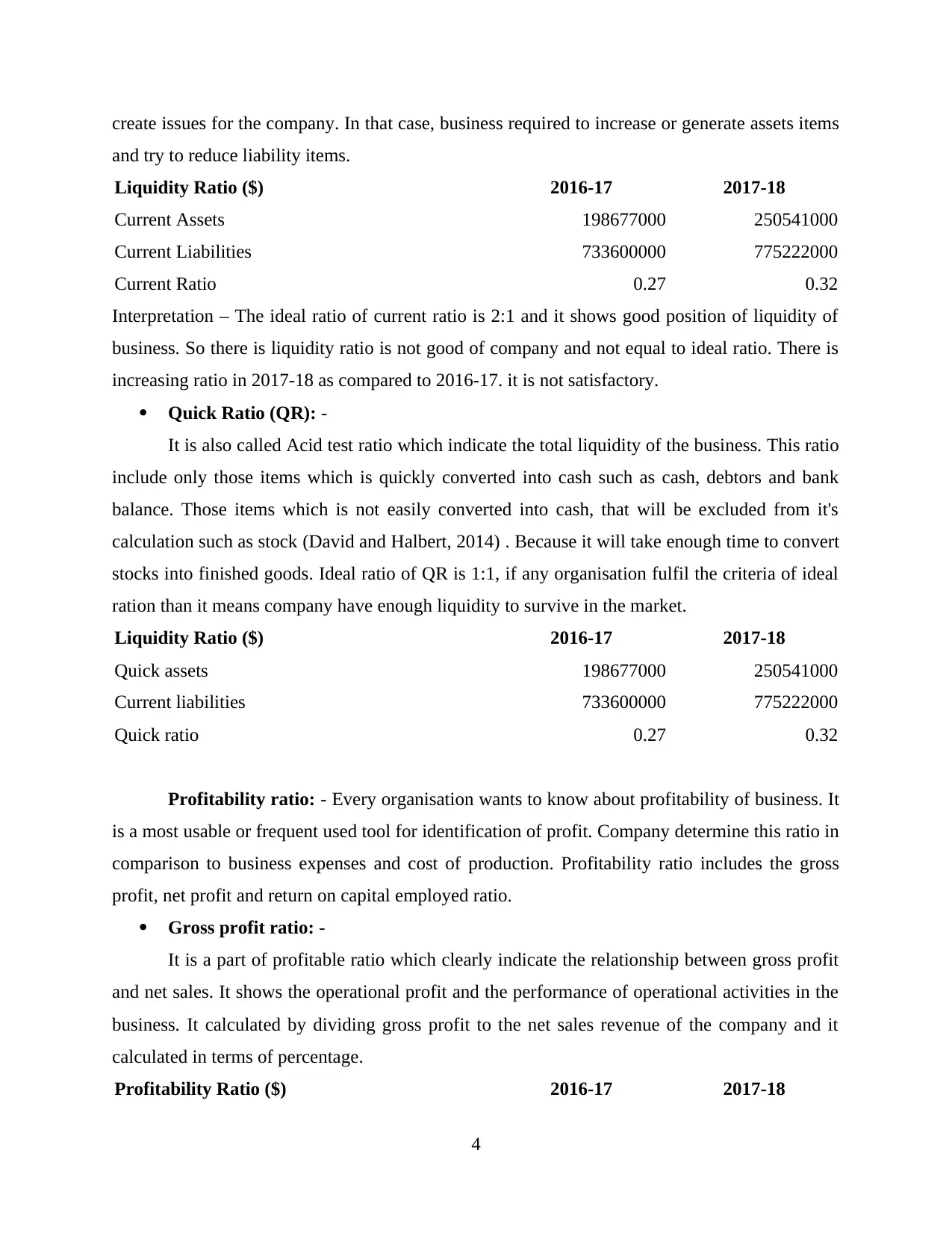
create issues for the company. In that case, business required to increase or generate assets items
and try to reduce liability items.
Liquidity Ratio ($) 2016-17 2017-18
Current Assets 198677000 250541000
Current Liabilities 733600000 775222000
Current Ratio 0.27 0.32
Interpretation – The ideal ratio of current ratio is 2:1 and it shows good position of liquidity of
business. So there is liquidity ratio is not good of company and not equal to ideal ratio. There is
increasing ratio in 2017-18 as compared to 2016-17. it is not satisfactory.
Quick Ratio (QR): -
It is also called Acid test ratio which indicate the total liquidity of the business. This ratio
include only those items which is quickly converted into cash such as cash, debtors and bank
balance. Those items which is not easily converted into cash, that will be excluded from it's
calculation such as stock (David and Halbert, 2014) . Because it will take enough time to convert
stocks into finished goods. Ideal ratio of QR is 1:1, if any organisation fulfil the criteria of ideal
ration than it means company have enough liquidity to survive in the market.
Liquidity Ratio ($) 2016-17 2017-18
Quick assets 198677000 250541000
Current liabilities 733600000 775222000
Quick ratio 0.27 0.32
Profitability ratio: - Every organisation wants to know about profitability of business. It
is a most usable or frequent used tool for identification of profit. Company determine this ratio in
comparison to business expenses and cost of production. Profitability ratio includes the gross
profit, net profit and return on capital employed ratio.
Gross profit ratio: -
It is a part of profitable ratio which clearly indicate the relationship between gross profit
and net sales. It shows the operational profit and the performance of operational activities in the
business. It calculated by dividing gross profit to the net sales revenue of the company and it
calculated in terms of percentage.
Profitability Ratio ($) 2016-17 2017-18
4
and try to reduce liability items.
Liquidity Ratio ($) 2016-17 2017-18
Current Assets 198677000 250541000
Current Liabilities 733600000 775222000
Current Ratio 0.27 0.32
Interpretation – The ideal ratio of current ratio is 2:1 and it shows good position of liquidity of
business. So there is liquidity ratio is not good of company and not equal to ideal ratio. There is
increasing ratio in 2017-18 as compared to 2016-17. it is not satisfactory.
Quick Ratio (QR): -
It is also called Acid test ratio which indicate the total liquidity of the business. This ratio
include only those items which is quickly converted into cash such as cash, debtors and bank
balance. Those items which is not easily converted into cash, that will be excluded from it's
calculation such as stock (David and Halbert, 2014) . Because it will take enough time to convert
stocks into finished goods. Ideal ratio of QR is 1:1, if any organisation fulfil the criteria of ideal
ration than it means company have enough liquidity to survive in the market.
Liquidity Ratio ($) 2016-17 2017-18
Quick assets 198677000 250541000
Current liabilities 733600000 775222000
Quick ratio 0.27 0.32
Profitability ratio: - Every organisation wants to know about profitability of business. It
is a most usable or frequent used tool for identification of profit. Company determine this ratio in
comparison to business expenses and cost of production. Profitability ratio includes the gross
profit, net profit and return on capital employed ratio.
Gross profit ratio: -
It is a part of profitable ratio which clearly indicate the relationship between gross profit
and net sales. It shows the operational profit and the performance of operational activities in the
business. It calculated by dividing gross profit to the net sales revenue of the company and it
calculated in terms of percentage.
Profitability Ratio ($) 2016-17 2017-18
4
⊘ This is a preview!⊘
Do you want full access?
Subscribe today to unlock all pages.

Trusted by 1+ million students worldwide

Gross profit 18200000 19143000
Net sales 18200000 19143000
Gross profit ratio 100% 100%
Net profit ratio: -
It is calculated by after deducting tax from profit, this is the net profit earned by the
company. It shows the relationship between net profit or net sales revenue.
Profitability Ratio ($) 2016-17 2017-18
Net profit 6406000 6400000
Net sales 18200000 19143000
Net profit ratio 35.20% 33.43%
Interpretation – The profit shows net profit and earns as compare to total turn over. In ANZ net
profit margin decreased in 2017-18 as compared to 2016-17.
Return on Capital Employed: -
It identify the efficiency of the organisation through this ratio. Business will generate
profit through capital employed by comparing net profit.
Profitability Ratio ($) 2016-17 2017-18
Total Assets 897326000 942624000
Capital employed 163726000 167402000
Return on capital employed 5.48 5.63
Market value ratio: - In this ratio security's market price compare with any item which
comes under any financial statement. This ratio is useful for the investors because they check
organisational statements on regular basis. Because they have potential to become investor of
the company.
Dividend yield: -
This ratio measure the amount which distributed by the organisation to it's shareholders.
Dividend yield represent the total amount earned by the inventors on their investment. It is
basically provide the rate of return on investment to their investors.
Market value Ratio ($) 2016-17 2017-18
Dividend yield ratio (as per final report) 8.1% 8.5%
5
Net sales 18200000 19143000
Gross profit ratio 100% 100%
Net profit ratio: -
It is calculated by after deducting tax from profit, this is the net profit earned by the
company. It shows the relationship between net profit or net sales revenue.
Profitability Ratio ($) 2016-17 2017-18
Net profit 6406000 6400000
Net sales 18200000 19143000
Net profit ratio 35.20% 33.43%
Interpretation – The profit shows net profit and earns as compare to total turn over. In ANZ net
profit margin decreased in 2017-18 as compared to 2016-17.
Return on Capital Employed: -
It identify the efficiency of the organisation through this ratio. Business will generate
profit through capital employed by comparing net profit.
Profitability Ratio ($) 2016-17 2017-18
Total Assets 897326000 942624000
Capital employed 163726000 167402000
Return on capital employed 5.48 5.63
Market value ratio: - In this ratio security's market price compare with any item which
comes under any financial statement. This ratio is useful for the investors because they check
organisational statements on regular basis. Because they have potential to become investor of
the company.
Dividend yield: -
This ratio measure the amount which distributed by the organisation to it's shareholders.
Dividend yield represent the total amount earned by the inventors on their investment. It is
basically provide the rate of return on investment to their investors.
Market value Ratio ($) 2016-17 2017-18
Dividend yield ratio (as per final report) 8.1% 8.5%
5
Paraphrase This Document
Need a fresh take? Get an instant paraphrase of this document with our AI Paraphraser
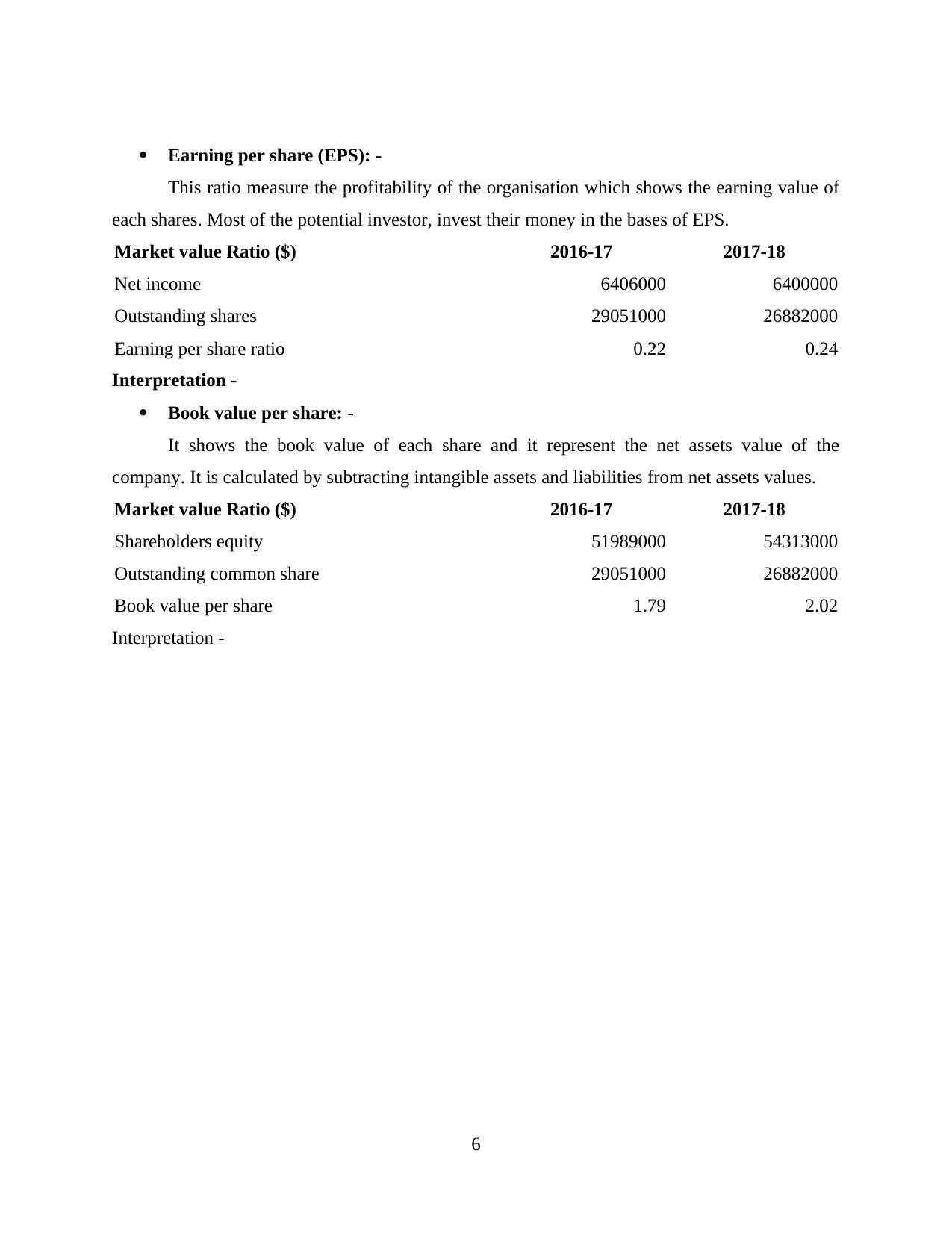
Earning per share (EPS): -
This ratio measure the profitability of the organisation which shows the earning value of
each shares. Most of the potential investor, invest their money in the bases of EPS.
Market value Ratio ($) 2016-17 2017-18
Net income 6406000 6400000
Outstanding shares 29051000 26882000
Earning per share ratio 0.22 0.24
Interpretation -
Book value per share: -
It shows the book value of each share and it represent the net assets value of the
company. It is calculated by subtracting intangible assets and liabilities from net assets values.
Market value Ratio ($) 2016-17 2017-18
Shareholders equity 51989000 54313000
Outstanding common share 29051000 26882000
Book value per share 1.79 2.02
Interpretation -
6
This ratio measure the profitability of the organisation which shows the earning value of
each shares. Most of the potential investor, invest their money in the bases of EPS.
Market value Ratio ($) 2016-17 2017-18
Net income 6406000 6400000
Outstanding shares 29051000 26882000
Earning per share ratio 0.22 0.24
Interpretation -
Book value per share: -
It shows the book value of each share and it represent the net assets value of the
company. It is calculated by subtracting intangible assets and liabilities from net assets values.
Market value Ratio ($) 2016-17 2017-18
Shareholders equity 51989000 54313000
Outstanding common share 29051000 26882000
Book value per share 1.79 2.02
Interpretation -
6
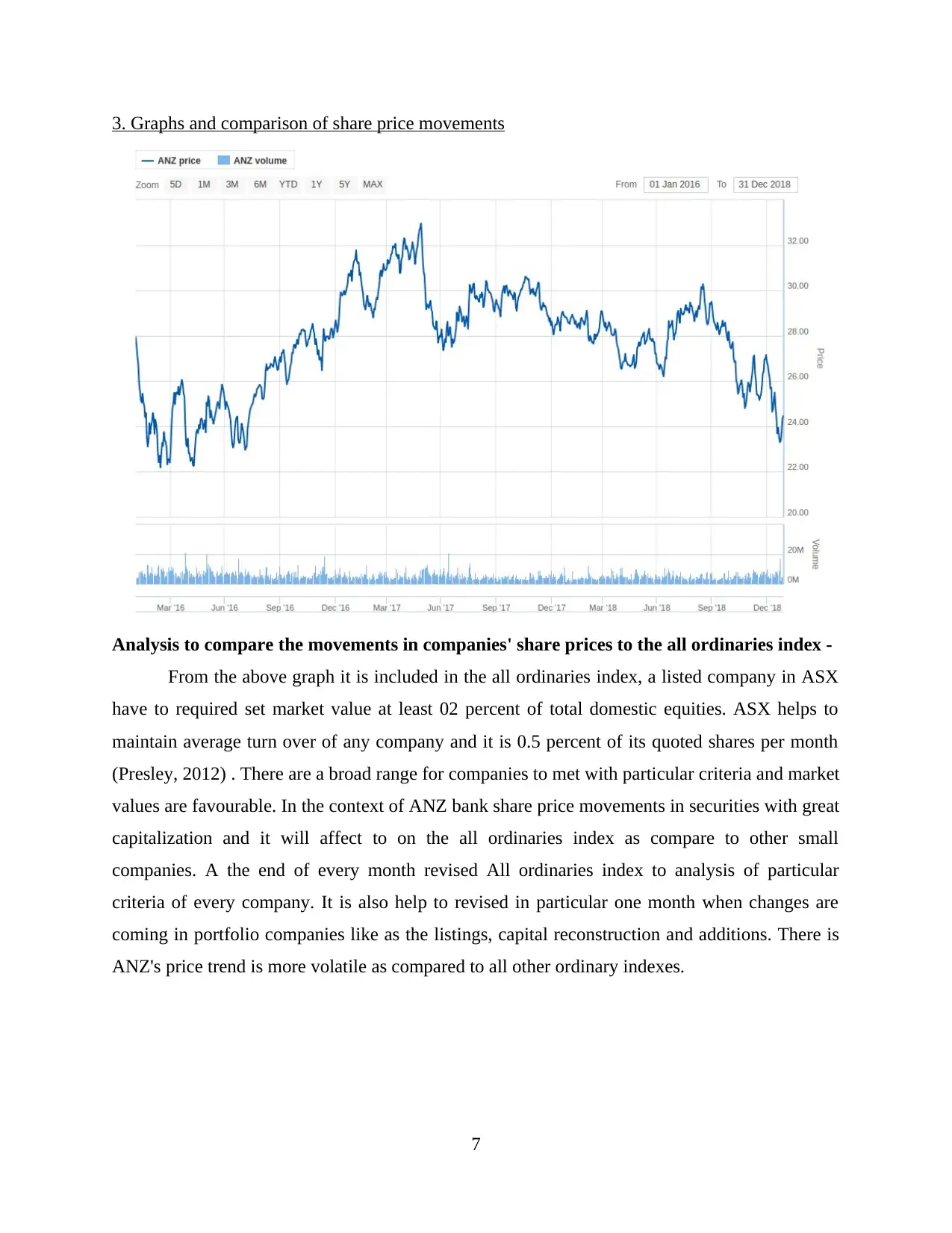
3. Graphs and comparison of share price movements
Analysis to compare the movements in companies' share prices to the all ordinaries index -
From the above graph it is included in the all ordinaries index, a listed company in ASX
have to required set market value at least 02 percent of total domestic equities. ASX helps to
maintain average turn over of any company and it is 0.5 percent of its quoted shares per month
(Presley, 2012) . There are a broad range for companies to met with particular criteria and market
values are favourable. In the context of ANZ bank share price movements in securities with great
capitalization and it will affect to on the all ordinaries index as compare to other small
companies. A the end of every month revised All ordinaries index to analysis of particular
criteria of every company. It is also help to revised in particular one month when changes are
coming in portfolio companies like as the listings, capital reconstruction and additions. There is
ANZ's price trend is more volatile as compared to all other ordinary indexes.
7
Analysis to compare the movements in companies' share prices to the all ordinaries index -
From the above graph it is included in the all ordinaries index, a listed company in ASX
have to required set market value at least 02 percent of total domestic equities. ASX helps to
maintain average turn over of any company and it is 0.5 percent of its quoted shares per month
(Presley, 2012) . There are a broad range for companies to met with particular criteria and market
values are favourable. In the context of ANZ bank share price movements in securities with great
capitalization and it will affect to on the all ordinaries index as compare to other small
companies. A the end of every month revised All ordinaries index to analysis of particular
criteria of every company. It is also help to revised in particular one month when changes are
coming in portfolio companies like as the listings, capital reconstruction and additions. There is
ANZ's price trend is more volatile as compared to all other ordinary indexes.
7
⊘ This is a preview!⊘
Do you want full access?
Subscribe today to unlock all pages.

Trusted by 1+ million students worldwide
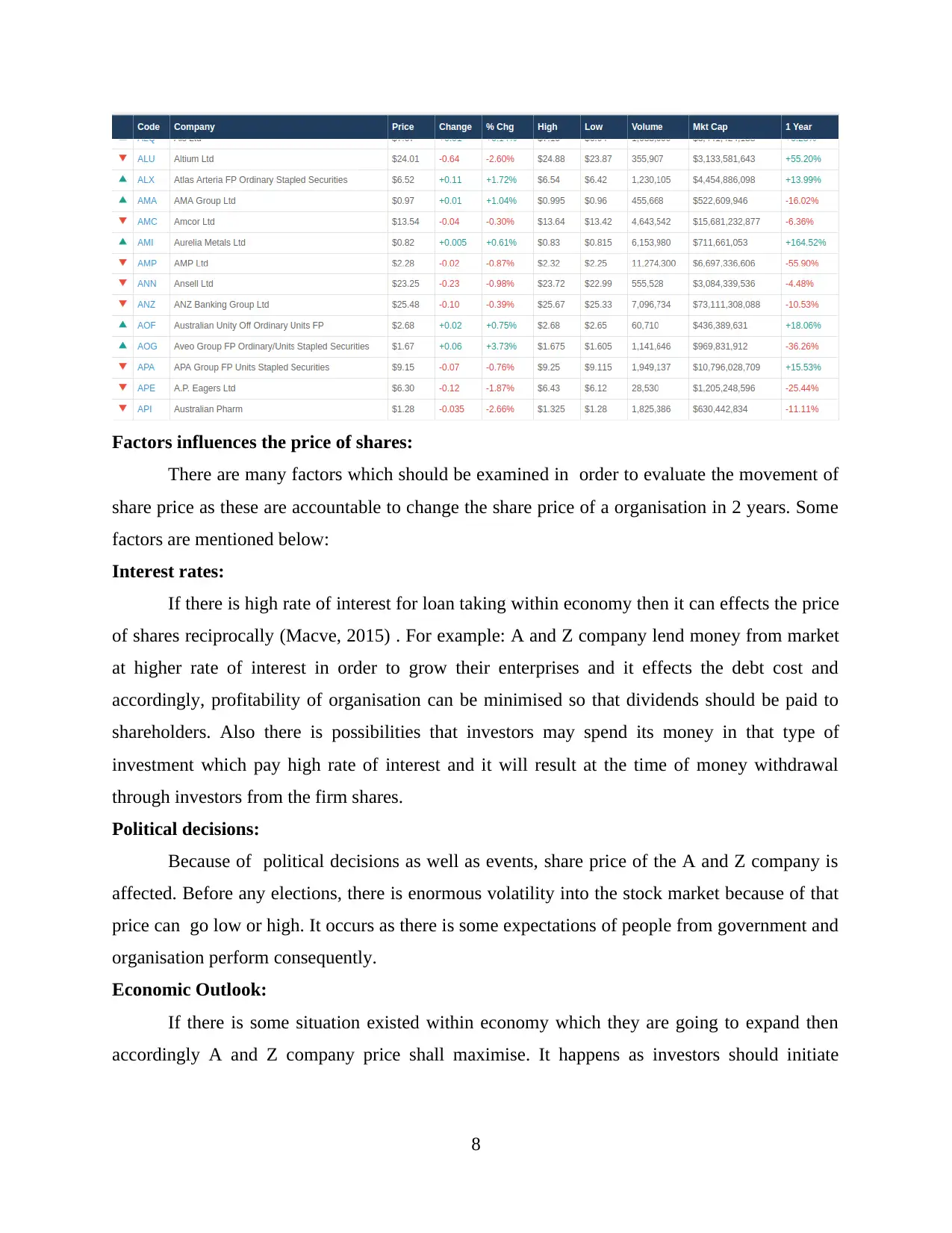
Factors influences the price of shares:
There are many factors which should be examined in order to evaluate the movement of
share price as these are accountable to change the share price of a organisation in 2 years. Some
factors are mentioned below:
Interest rates:
If there is high rate of interest for loan taking within economy then it can effects the price
of shares reciprocally (Macve, 2015) . For example: A and Z company lend money from market
at higher rate of interest in order to grow their enterprises and it effects the debt cost and
accordingly, profitability of organisation can be minimised so that dividends should be paid to
shareholders. Also there is possibilities that investors may spend its money in that type of
investment which pay high rate of interest and it will result at the time of money withdrawal
through investors from the firm shares.
Political decisions:
Because of political decisions as well as events, share price of the A and Z company is
affected. Before any elections, there is enormous volatility into the stock market because of that
price can go low or high. It occurs as there is some expectations of people from government and
organisation perform consequently.
Economic Outlook:
If there is some situation existed within economy which they are going to expand then
accordingly A and Z company price shall maximise. It happens as investors should initiate
8
There are many factors which should be examined in order to evaluate the movement of
share price as these are accountable to change the share price of a organisation in 2 years. Some
factors are mentioned below:
Interest rates:
If there is high rate of interest for loan taking within economy then it can effects the price
of shares reciprocally (Macve, 2015) . For example: A and Z company lend money from market
at higher rate of interest in order to grow their enterprises and it effects the debt cost and
accordingly, profitability of organisation can be minimised so that dividends should be paid to
shareholders. Also there is possibilities that investors may spend its money in that type of
investment which pay high rate of interest and it will result at the time of money withdrawal
through investors from the firm shares.
Political decisions:
Because of political decisions as well as events, share price of the A and Z company is
affected. Before any elections, there is enormous volatility into the stock market because of that
price can go low or high. It occurs as there is some expectations of people from government and
organisation perform consequently.
Economic Outlook:
If there is some situation existed within economy which they are going to expand then
accordingly A and Z company price shall maximise. It happens as investors should initiate
8
Paraphrase This Document
Need a fresh take? Get an instant paraphrase of this document with our AI Paraphraser
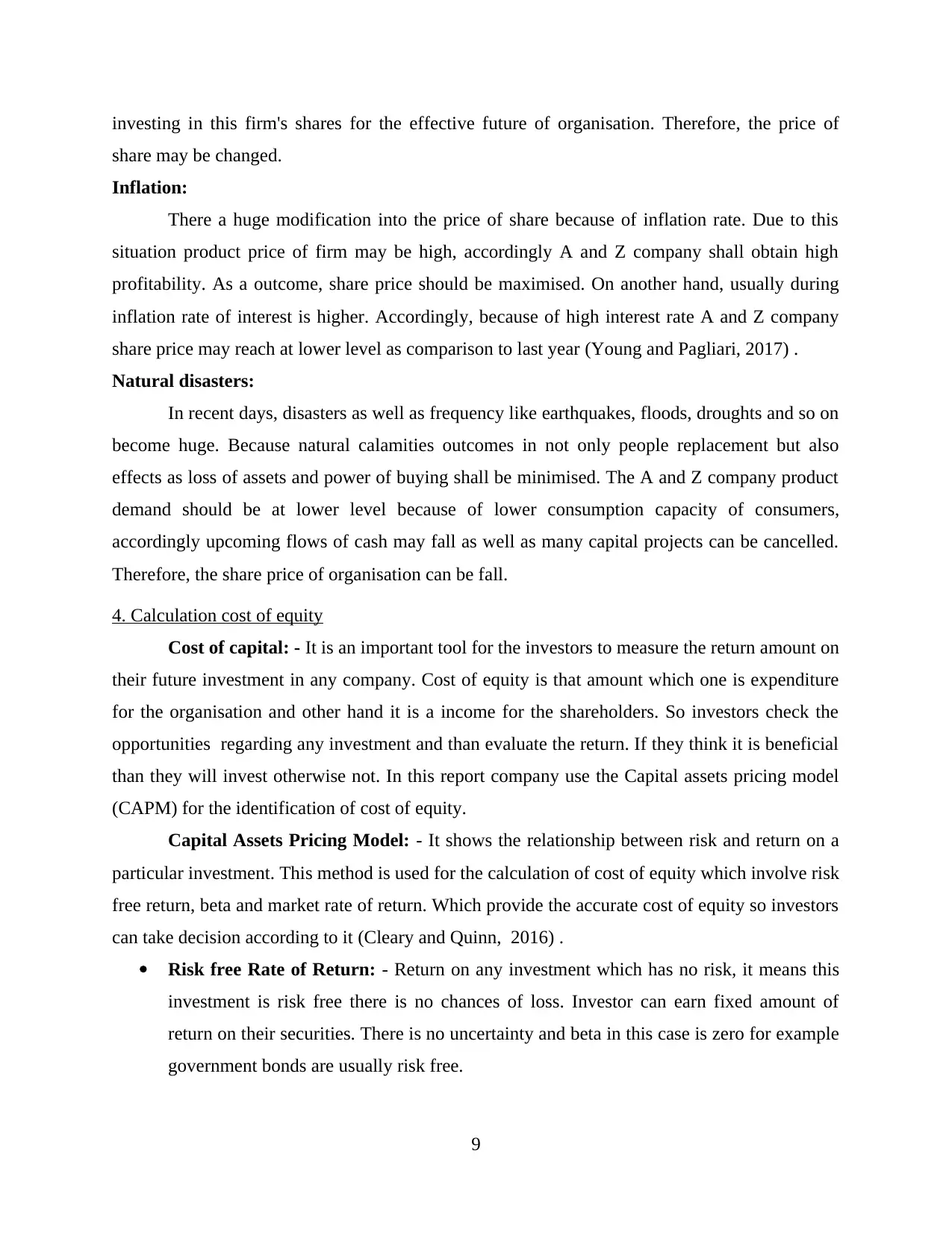
investing in this firm's shares for the effective future of organisation. Therefore, the price of
share may be changed.
Inflation:
There a huge modification into the price of share because of inflation rate. Due to this
situation product price of firm may be high, accordingly A and Z company shall obtain high
profitability. As a outcome, share price should be maximised. On another hand, usually during
inflation rate of interest is higher. Accordingly, because of high interest rate A and Z company
share price may reach at lower level as comparison to last year (Young and Pagliari, 2017) .
Natural disasters:
In recent days, disasters as well as frequency like earthquakes, floods, droughts and so on
become huge. Because natural calamities outcomes in not only people replacement but also
effects as loss of assets and power of buying shall be minimised. The A and Z company product
demand should be at lower level because of lower consumption capacity of consumers,
accordingly upcoming flows of cash may fall as well as many capital projects can be cancelled.
Therefore, the share price of organisation can be fall.
4. Calculation cost of equity
Cost of capital: - It is an important tool for the investors to measure the return amount on
their future investment in any company. Cost of equity is that amount which one is expenditure
for the organisation and other hand it is a income for the shareholders. So investors check the
opportunities regarding any investment and than evaluate the return. If they think it is beneficial
than they will invest otherwise not. In this report company use the Capital assets pricing model
(CAPM) for the identification of cost of equity.
Capital Assets Pricing Model: - It shows the relationship between risk and return on a
particular investment. This method is used for the calculation of cost of equity which involve risk
free return, beta and market rate of return. Which provide the accurate cost of equity so investors
can take decision according to it (Cleary and Quinn, 2016) .
Risk free Rate of Return: - Return on any investment which has no risk, it means this
investment is risk free there is no chances of loss. Investor can earn fixed amount of
return on their securities. There is no uncertainty and beta in this case is zero for example
government bonds are usually risk free.
9
share may be changed.
Inflation:
There a huge modification into the price of share because of inflation rate. Due to this
situation product price of firm may be high, accordingly A and Z company shall obtain high
profitability. As a outcome, share price should be maximised. On another hand, usually during
inflation rate of interest is higher. Accordingly, because of high interest rate A and Z company
share price may reach at lower level as comparison to last year (Young and Pagliari, 2017) .
Natural disasters:
In recent days, disasters as well as frequency like earthquakes, floods, droughts and so on
become huge. Because natural calamities outcomes in not only people replacement but also
effects as loss of assets and power of buying shall be minimised. The A and Z company product
demand should be at lower level because of lower consumption capacity of consumers,
accordingly upcoming flows of cash may fall as well as many capital projects can be cancelled.
Therefore, the share price of organisation can be fall.
4. Calculation cost of equity
Cost of capital: - It is an important tool for the investors to measure the return amount on
their future investment in any company. Cost of equity is that amount which one is expenditure
for the organisation and other hand it is a income for the shareholders. So investors check the
opportunities regarding any investment and than evaluate the return. If they think it is beneficial
than they will invest otherwise not. In this report company use the Capital assets pricing model
(CAPM) for the identification of cost of equity.
Capital Assets Pricing Model: - It shows the relationship between risk and return on a
particular investment. This method is used for the calculation of cost of equity which involve risk
free return, beta and market rate of return. Which provide the accurate cost of equity so investors
can take decision according to it (Cleary and Quinn, 2016) .
Risk free Rate of Return: - Return on any investment which has no risk, it means this
investment is risk free there is no chances of loss. Investor can earn fixed amount of
return on their securities. There is no uncertainty and beta in this case is zero for example
government bonds are usually risk free.
9
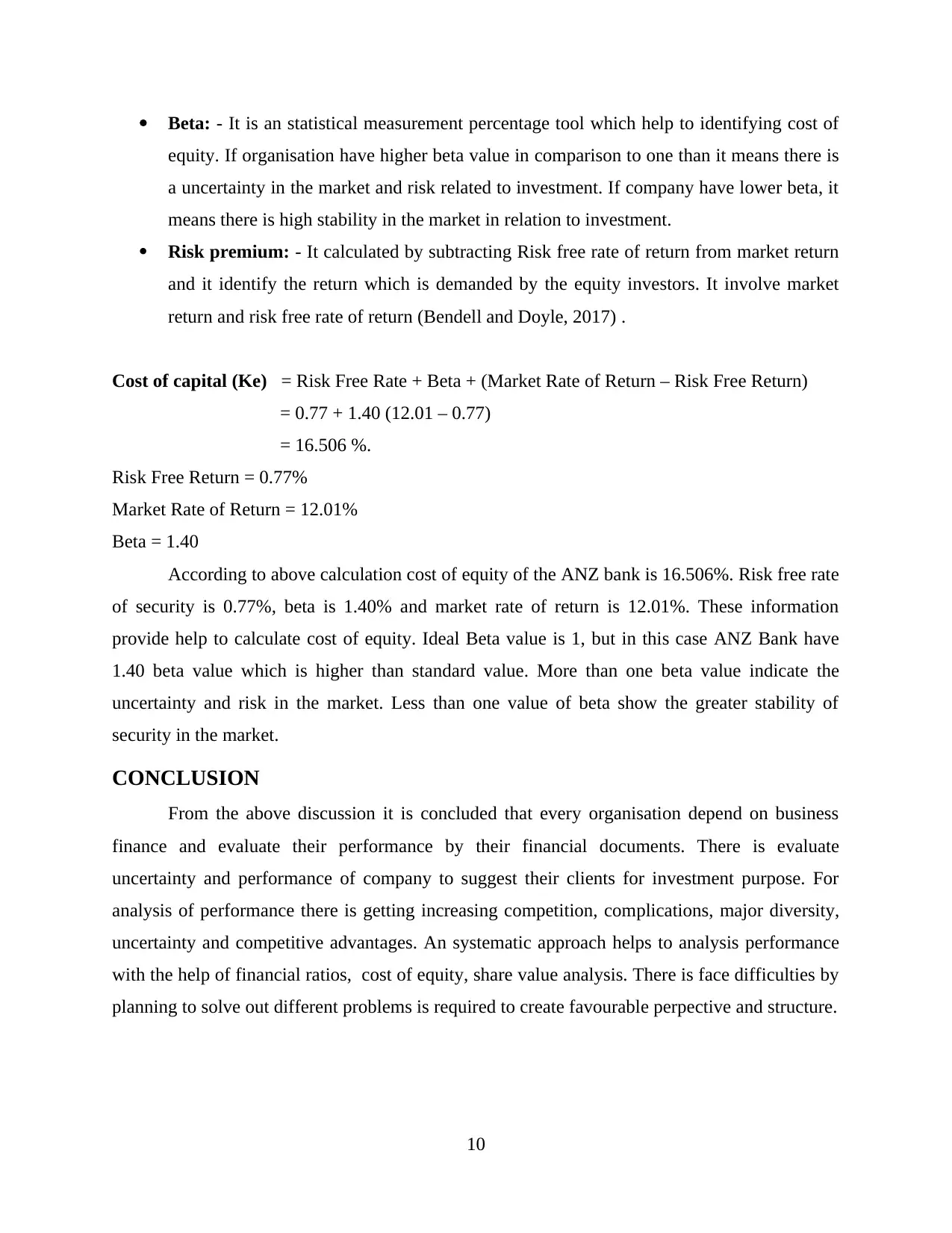
Beta: - It is an statistical measurement percentage tool which help to identifying cost of
equity. If organisation have higher beta value in comparison to one than it means there is
a uncertainty in the market and risk related to investment. If company have lower beta, it
means there is high stability in the market in relation to investment.
Risk premium: - It calculated by subtracting Risk free rate of return from market return
and it identify the return which is demanded by the equity investors. It involve market
return and risk free rate of return (Bendell and Doyle, 2017) .
Cost of capital (Ke) = Risk Free Rate + Beta + (Market Rate of Return – Risk Free Return)
= 0.77 + 1.40 (12.01 – 0.77)
= 16.506 %.
Risk Free Return = 0.77%
Market Rate of Return = 12.01%
Beta = 1.40
According to above calculation cost of equity of the ANZ bank is 16.506%. Risk free rate
of security is 0.77%, beta is 1.40% and market rate of return is 12.01%. These information
provide help to calculate cost of equity. Ideal Beta value is 1, but in this case ANZ Bank have
1.40 beta value which is higher than standard value. More than one beta value indicate the
uncertainty and risk in the market. Less than one value of beta show the greater stability of
security in the market.
CONCLUSION
From the above discussion it is concluded that every organisation depend on business
finance and evaluate their performance by their financial documents. There is evaluate
uncertainty and performance of company to suggest their clients for investment purpose. For
analysis of performance there is getting increasing competition, complications, major diversity,
uncertainty and competitive advantages. An systematic approach helps to analysis performance
with the help of financial ratios, cost of equity, share value analysis. There is face difficulties by
planning to solve out different problems is required to create favourable perpective and structure.
10
equity. If organisation have higher beta value in comparison to one than it means there is
a uncertainty in the market and risk related to investment. If company have lower beta, it
means there is high stability in the market in relation to investment.
Risk premium: - It calculated by subtracting Risk free rate of return from market return
and it identify the return which is demanded by the equity investors. It involve market
return and risk free rate of return (Bendell and Doyle, 2017) .
Cost of capital (Ke) = Risk Free Rate + Beta + (Market Rate of Return – Risk Free Return)
= 0.77 + 1.40 (12.01 – 0.77)
= 16.506 %.
Risk Free Return = 0.77%
Market Rate of Return = 12.01%
Beta = 1.40
According to above calculation cost of equity of the ANZ bank is 16.506%. Risk free rate
of security is 0.77%, beta is 1.40% and market rate of return is 12.01%. These information
provide help to calculate cost of equity. Ideal Beta value is 1, but in this case ANZ Bank have
1.40 beta value which is higher than standard value. More than one beta value indicate the
uncertainty and risk in the market. Less than one value of beta show the greater stability of
security in the market.
CONCLUSION
From the above discussion it is concluded that every organisation depend on business
finance and evaluate their performance by their financial documents. There is evaluate
uncertainty and performance of company to suggest their clients for investment purpose. For
analysis of performance there is getting increasing competition, complications, major diversity,
uncertainty and competitive advantages. An systematic approach helps to analysis performance
with the help of financial ratios, cost of equity, share value analysis. There is face difficulties by
planning to solve out different problems is required to create favourable perpective and structure.
10
⊘ This is a preview!⊘
Do you want full access?
Subscribe today to unlock all pages.

Trusted by 1+ million students worldwide
1 out of 13
Related Documents
Your All-in-One AI-Powered Toolkit for Academic Success.
+13062052269
info@desklib.com
Available 24*7 on WhatsApp / Email
![[object Object]](/_next/static/media/star-bottom.7253800d.svg)
Unlock your academic potential
Copyright © 2020–2025 A2Z Services. All Rights Reserved. Developed and managed by ZUCOL.




